thebluesteye最蓝的眼睛(课堂)
- 格式:pdf
- 大小:14.71 MB
- 文档页数:93
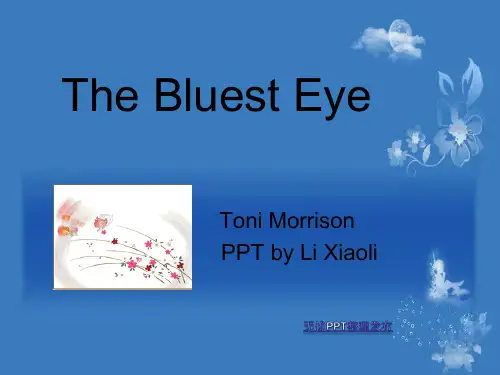
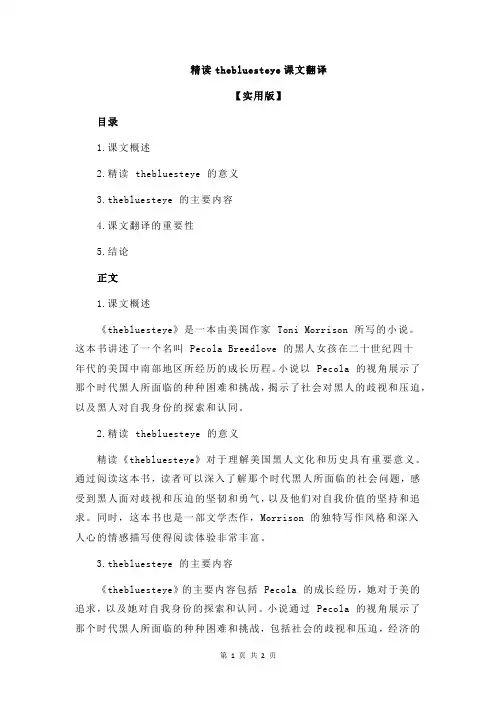
精读thebluesteye课文翻译【实用版】目录1.课文概述2.精读 thebluesteye 的意义3.thebluesteye 的主要内容4.课文翻译的重要性5.结论正文1.课文概述《thebluesteye》是一本由美国作家 Toni Morrison 所写的小说。
这本书讲述了一个名叫 Pecola Breedlove 的黑人女孩在二十世纪四十年代的美国中南部地区所经历的成长历程。
小说以 Pecola 的视角展示了那个时代黑人所面临的种种困难和挑战,揭示了社会对黑人的歧视和压迫,以及黑人对自我身份的探索和认同。
2.精读 thebluesteye 的意义精读《thebluesteye》对于理解美国黑人文化和历史具有重要意义。
通过阅读这本书,读者可以深入了解那个时代黑人所面临的社会问题,感受到黑人面对歧视和压迫的坚韧和勇气,以及他们对自我价值的坚持和追求。
同时,这本书也是一部文学杰作,Morrison 的独特写作风格和深入人心的情感描写使得阅读体验非常丰富。
3.thebluesteye 的主要内容《thebluesteye》的主要内容包括 Pecola 的成长经历,她对于美的追求,以及她对自我身份的探索和认同。
小说通过 Pecola 的视角展示了那个时代黑人所面临的种种困难和挑战,包括社会的歧视和压迫,经济的贫困和落后,以及家庭的破裂和暴力。
同时,小说也揭示了黑人对自我身份的探索和认同,他们坚持自己的文化和价值观,追求自由和平等,以及他们对美的追求和热爱。
4.课文翻译的重要性对于中国读者来说,阅读《thebluesteye》的英文原文可能存在一些语言和文化上的障碍。
因此,将这本书翻译成中文,使得更多的读者能够理解和欣赏,具有重要意义。
通过阅读中文翻译,中国读者可以更好地理解美国黑人文化和历史,感受到黑人面对歧视和压迫的坚韧和勇气,以及他们对自我价值的坚持和追求。
同时,中文翻译也可以使得中国读者更好地理解 Morrison 的独特写作风格和深入人心的情感描写。
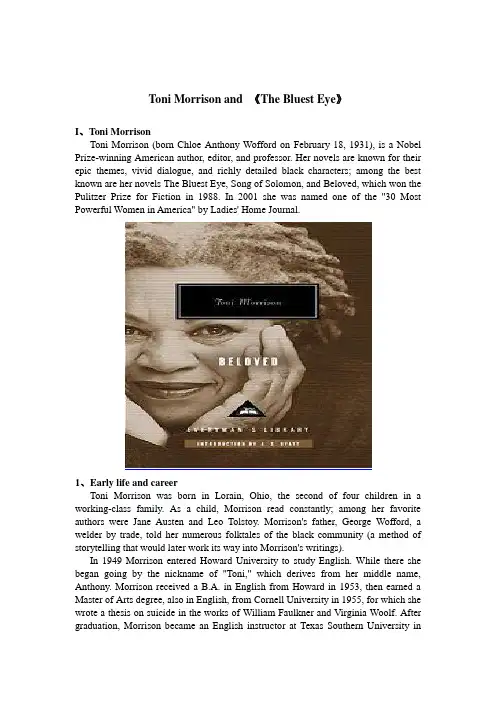
Toni Morrison and 《The Bluest Eye》I、Toni MorrisonToni Morrison (born Chloe Anthony Wofford on February 18, 1931), is a Nobel Prize-winning American author, editor, and professor. Her novels are known for their epic themes, vivid dialogue, and richly detailed black characters; among the best known are her novels The Bluest Eye, Song of Solomon, and Beloved, which won the Pulitzer Prize for Fiction in 1988. In 2001 she was named one of the "30 Most Powerful Women in America" by Ladies' Home Journal.1、Early life and careerToni Morrison was born in Lorain, Ohio, the second of four children in a working-class family. As a child, Morrison read constantly; among her favorite authors were Jane Austen and Leo Tolstoy. Morrison's father, George Wofford, a welder by trade, told her numerous folktales of the black community (a method of storytelling that would later work its way into Morrison's writings).In 1949 Morrison entered Howard University to study English. While there she began going by the nickname of "Toni," which derives from her middle name, Anthony. Morrison received a B.A. in English from Howard in 1953, then earned a Master of Arts degree, also in English, from Cornell University in 1955, for which she wrote a thesis on suicide in the works of William Faulkner and Virginia Woolf. After graduation, Morrison became an English instructor at Texas Southern University inHouston, Texas (from 1955-57) then returned to Howard to teach English. She became a member of Alpha Kappa Alpha Sorority, Inc.In 1958 she married Harold Morrison. They had two children, Harold and Slade, and divorced in 1964. After the divorce she moved to Syracuse, New York, where she worked as a textbook editor. Eighteen months later she went to work as an editor at the New York City headquarters of Random House.As an editor, Morrison played an important role in bringing African American literature into the mainstream. She edited books by such black authors as Toni Cade Bambara, Angela Davis and Gayl Jones.2、Writing careerMorrison began writing fiction as part of an informal group of poets and writers at Howard University who met to discuss their work. She went to one meeting with a short story about a black girl who longed to have blue eyes. The story later evolved into her first novel, The Bluest Eye (1970), which she wrote while raising two children and teaching at Howard. In 2000 it was chosen as a selection for Oprah's Book Club.In 1973 her novel Sula was nominated for the National Book Award. Her third novel, Song of Solomon (1977), brought her national attention. The book was a main selection of the Book-of-the-Month Club, the first novel by a black writer to be so chosen since Richard Wright's Native Son in 1940. It won the National Book Critics Circle Award.In 1988 Morrison's novel Beloved became a critical success. When the novel failed to win the National Book Award as well as the National Book Critics Circle Award, a number of writers protested the omission. Shortly afterward, it won the Pulitzer Prize for fiction. Beloved was adapted into the 1998 film of the same name starring Oprah Winfrey and Danny Glover. Morrison later used Margaret Garner's life story again in an opera, Margaret Garner, with music by Richard Danielpour. In May 2006, The New York Times Book Review named Beloved the best American novel published in the previous twenty five years.In 1993 Morrison was awarded the Nobel Prize in Literature, the first black woman to win it. Her citation reads: Toni Morrison, "who in novels characterized by visionary force and poetic import, gives life to an essential aspect of American reality." Shortly afterwards, a fire destroyed her Rockland County, New York home. Although her novels typically concentrate on black women, Morrison does not identify her works as feminist. She has stated that she thinks "it's off-putting to some readers, who may feel that I'm involved in writing some kind of feminist tract. I don't subscribe to patriarchy, and I don't think it should be substituted with matriarchy. I think it's a question of equitable access, and opening doors to all sorts of things. In addition to her novels, Morrison has also co-written books for children with her youngest son, Slade Morrison, who works as a painter and musician.3、Later lifeMorrison taught English at two branches of the State University of New York. In 1984 she was appointed to an Albert Schweitzer chair at the University at Albany, The State University of New York. From 1989 until her retirement in 2006, Morrison heldthe Robert F. Goheen Chair in the Humanities at Princeton University.Though based in the Creative Writing Program, Morrison did not regularly offer writing workshops to students after the late 1990s, a fact that earned her some criticism. Rather, she has conceived and developed the prestigious Princeton Atelier, a program that brings together talented students with critically acclaimed, world-famous artists. Together the students and the artists produce works of art that are presented to the public after a semester of collaboration. In her position at Princeton, Morrison used her insights to encourage not merely new and emerging writers, but artists working to develop new forms of art through interdisciplinary play and cooperation. At its 1979 commencement ceremonies, Barnard College awarded her its highest honor, the Barnard Medal of Distinction. Oxford University awarded her an honorary Doctor of Letters degree in June 2005.In November 2006, Morrison visited the Louvre Museum in Paris as the second in its "Grand Invité" program to guest-curate a month-long series of events across the arts on the theme of "The Foreigner's Home."She currently holds a place on the editorial board of The Nation magazine.PoliticsMorrison caused a stir when she called Bill Clinton "the first Black President;" saying "Clinton displays almost every trope of blackness: single-parent household, born poor, working-class, saxophone-playing, McDonald's-and-junk-food-loving boy from Arkansas." This opinion was both adopted by Clinton supporters like the Congressional Black Caucus (CBC) and ridiculed by critics. It should be noted that, in the context of the 2008 Democratic Primary campaign, during which Clinton made some remarks that were construed as unsympathetic to African-Americans, Morrison revisited her statement. Morrison stated to Salon magazine: "People misunderstood that phrase. I was deploring the way in which President Clinton was being treated, vis-à-vis the sex scandal that was surrounding him. I said he was being treated like a black on the street, already guilty, already a perp. I have no idea what his real instincts are, in terms of race." However, in the 2008 presidential race, Morrison has endorsed Senator Barack Obama over Senator Hillary Clinton.II、The Bluest EyeThe Bluest Eye is 1970 novel by American author Nobel Prize recipient Toni Morrison. Morrison's first novel, which was written while Morrison taught at Howard University and was raising her two sons on her own, the story is about a year in the life of a young black girl in Lorain, Ohio named Pecola. It takes place against the backdrop of America's Midwest as well as the Great Depression. The Bluest Eye is told from five perspectives: Pecola's, her mother's, her father's, her friend Claudia's, and Soaphead Church's. Because of the controversial nature of the book, which deals with racism, incest, and child molestation, there have been numerous attempts to ban it from schools and libraries. In 2000, the novel became a selection for Oprah's Book Club.1、Plot summaryThe narrator advises the reader not to look at the "why" of the story but at the "how." The novel, with child sex, irresponsible adults, and corrupt society seeks to show the misery of black people living in a white society. When she indirectly refers to Pecola as "dirt" and to the Breedloves as animals, she is exposing the ills to which they are submitted. Soaphead Church's letter to God is a summary of the insanity of the world around him, as the novel could be for the author. The Bluest Eye is the story of eleven-year-old Pecola Breedlove--a black girl who is regarded “ugly” by everyone, including her parents--who prays for her eyes to turn blue: so that she will be beautiful, so that people will look at her, so that her world will be different. She is raped by her drunk father and get pregnant, later she gives birth to a stillborn(夭折的)child. Finally Pecola lose her mind and spend the rest of her life as a madwoman thinking she has the bluest eyes of the world…Pecola's parents' history is examined throughout the novel, showing who they are in three main parts: her father Cholly's background, her mother Pauline's past life, and the couple's conflicted marriage. Cholly was deserted by both his parents, and was rebuked when he tried to contact his father. His son seems to do the same thing later on, running away repeatedly.In the afterword, Morrison explains that she is attempting to humanize all the characters that attack Pecola or cause her to be the way she is; that it is not a matter where one person can be pointed out as being the cause of all this pain.Ideas of beauty, particularly those that relate to racial characteristics, are a majortheme in this book. The title refers to Pecola's wish that her eyes would turn blue. Claudia is given a white baby doll to play with and is constantly told how lovely it is. Insults to the appearance are often given in racial terms. A light-skinned schoolmate is favored by the teachers.There is a contrast between the world shown in the cinema, the one in which Pauline is a servant, the WASP society, and the existence the main characters live in. Most chapters' titles are extracts from a Dick and Jane reading book, presenting a happy white family. This family is contrasted with Pecola's existence.ThemeSource of the tragedy: black people accepted and internalized white values and developed self-contempt and self-hatred for themselves or other black people, making some of their own people victims and scapegoats .The impact of mainstream white culture upon black people, which make them victim of the circumstances.2、CharactersPecola Breedlove - The protagonist of the novel, a poor black girl who believes she is ugly because she and her community base their ideals of beauty on "whiteness". The title The Bluest Eye is based on Pecola's fervent wishes for beautiful blue eyes. She is rarely developed during the story, which is purposely done to underscore the actions of the other characters. Her insanity at the end of the novel is her only way to escape the world where she cannot be beautiful and to get those blue eyes she wanted to get since the beginning of the novel.Cholly Breedlove - Pecola's abusive father, an alcoholic man who rapes his daughter at the end of the novel. Rejected by his father and discarded by his mother as a four day old baby, Cholly was raised by his Great Aunt Jimmy. After she dies, Cholly runs away and pursues the life of a "free man", yet he is never able to escape his painful past, nor can he live with the mistakes of his present. Tragically, he rapes his daughter in a gesture of madness mingled with affection. He realizes he loves her, but the only way he can express it is to rape her.Pauline Breedlove - Pecola's mother. Mrs. Breedlove is married to Cholly and lives the self-righteous life of a martyr, enduring her drunk husband and raising her two awkward children as best she can. Mrs. Breedlove is a bit of an outcast herself with her shriveled foot and Southern background. Mrs. Breedlove lives the life of a lonely and isolated character who escapes into a world of dreams, hopes and fantasy that turns into the motion pictures she enjoys viewing.Sam Breedlove - Pecola's older brother. Sammy is Cholly and Mrs. Breedlove's one son. Sam's part in this novel is relatively low key. Like his sister Pecola, he is affected by the disharmony in their home and deals with his anger by running away from home.Claudia MacTeer - Much of the novel is told from the perspective of Claudia. She is the primary narrator in the book. Claudia is Pecola's friend and the younger sister of Frieda MacTeer. The MacTeer family serves as a foil for the Breedloves, and althoughboth families are poor, Mr. and Mrs. MacTeer are strict but loving parents towards their children - a sharp contrast to the dysfunctional home of the Breedloves.Frieda MacTeer - Claudia's older sister and close companion. The two MacTeer girls are often seen together and while most of the story is told through Claudia's eyes, her sister Frieda plays a large role in the novel.Henry Washington - a man who comes to live with the MacTeer family and is subsequently thrown out by Claudia's father when he inappropriately touches Frieda. Soaphead Church - a pedophile and mystic fortune teller who "grants" Pecola her wish for blue eyes. The character is somewhat based on Morrison's Jamaican ex-husband.Great Aunt Jimmy - Cholly's aunt who takes him in to raise after his parents abandon him. She dies when he is a young boy.Maureen Peal - A light-skinned, wealthy mulatto girl who is new at the local school. She accepts everyone else’s assumption that she is superior and is capable of both generosity and cruelty. She changes her attitude throughout the novel towards Pecola.3、AdaptationThe Steppenwolf Theatre Company in Chicago, Illinois commissioned Lydia R. Diamond to adapt the novel into a full-length stage production. The play was developed through the Steppenwolf for Young Adults and the New Plays Initiative where it received its world premiere in February, 2005. The play was reprised in Chicago at the Steppenwolf Theatre in October, 2006 by popular demand. The Bluest Eye received its off-Broadway premiere at the New Victory Theater in New York in November, 2006.The Bluest Eye written by African American writer Toni Morrison narrates a tragic story about a black girl who longs for a pair of blue eyes owned exclusively by white people. Strongly influenced by white dominated culture, many other black women are also lost in the myth of white beauty. However, in addition to the description of this negative impact, Morrison, in her novel, also explores effective approaches to demystify the myth of white beauty and maintain the real-self of the black people through the voice of a rebellious narrator.4、MotifsMotifs are recurring structures, contrasts, or literary devices that can help to develop and inform the text’s major themes.The Dick-and-Jane NarrativeThe novel opens with a narrative from a Dick-and-Jane reading primer, a narrative that is distorted when Morrison runs its sentences and then its words together. The gap between the idealized, sanitized, upper-middle-class world of Dick and Jane (who we assume to be white, though we are never told so) and the often dark and ugly world of the novel is emphasized by the chapter headings excerpted from the primer. But Morrison does not mean for us to think that the Dick-and-Jane world is better—in fact, it is largely because the black characters have internalized white Dick-and-Jane values that they are unhappy. In this way, the Dick and Jane narrative and the novel provide ironic commentary on each other.The Seasons and NatureThe novel is divided into the four seasons, but it pointedly refuses to meet the expectations of these seasons. For example, spring, the traditional time of rebirth and renewal, reminds Claudia of being whipped with new switches, and it is the season when Pecola’s is raped. Pecola’s baby dies in autumn, the season of harvesting. Morrison uses natural cycles to underline the unnaturalness and misery of her characters’ ex periences. To some degree, she also questions the benevolence of nature, as when Claudia wonders whether “the earth itself might have been unyielding” to someone like Pecola.Whiteness and ColorIn the novel, whiteness is associated with beauty and cleanliness (particularly according to Geraldine and Mrs. Breedlove), but also with sterility. In contrast, color is associated with happiness, most clearly in the rainbow of yellow, green, and purple memories Pauline Breedlove sees when making love with Cholly. Morrison uses this imagery to emphasize the destructiveness of the black community’s privileging of whiteness and to suggest that vibrant color, rather than the pure absence of color, is a stronger image of happiness and freedom.Eyes and VisionPecola is obsessed with having blue eyes because she believes that this mark of conventional, white beauty will change the way that she is seen and therefore the way that she sees the world. There are continual references to other characters’ eyes as well—for example, Mr. Yacobowski’s hostility to Pecola resides in the blankness in his own eyes, as well as in his inability to see a black girl. This motif underlines the novel’s repeated concern for the difference between how we see and how we are seen, and the difference between superficial sight and true insight.Dirtiness and CleanlinessThe black characters in the novel who have internalized white, -middle-class values are obsessed with cleanliness. Geraldine and Mrs. Breedlove are excessively concerned with housecleaning—though Mrs. Breedlove cleans only the house of her white employers, as if the Breedlove apartment is beyond her help. This fixation on cleanliness extends into the women’s moral and emotional quests for purity, but the obsession with domestic and moral sanitation leads them to cruel coldness. In contrast, one mark of Claudia’s strength of character is her pleasure in her own dirt, a pleasure that represents self-confidence and a correct understanding of the nature of happiness.5、SymbolsSymbols are objects, characters, figures, or colors used to represent abstract ideas or concepts.The HouseThe novel begins with a sentence from a Dick-and-Jane narrative: “Here is thehouse.” Homes not only indicate socioeconomic status in this novel,but they also symbolize the emotional situations and values of the characters who inhabit them. The Breedlove -apartment is miserable and decrepit, suffering from Mrs. Breedlove’s preference for her employer’s home over her own and symbolizing the misery of the Breedlove family. The MacTeer house is drafty and dark, but it is carefully tended by Mrs. MacTeer and, according to Claudia, filled with love, symbolizing that family’s comparative cohesion.Bluest Eye(s)To Pecola, blue eyes symbolize the beauty and happiness that she associates with the white, middle-class world. They also come to symbolize her own blindness, for she gains blue eyes only at the cost of her sanity. The “bluest” eye could also mean the saddest eye. Furthermore, eye puns on I, in t he sense that the novel’s title uses the singular form of the noun (instead of The Bluest Eyes) to express many of the characters’ sad isolation.The MarigoldsClaudia and Frieda associate marigolds with the safety and well-being of Pecola’s baby. Their ceremonial offering of money and the remaining unsold marigold seeds represents an honest sacrifice on their part. They believe that if the marigolds they have planted grow, then Pecola’s baby will be all right. More generally, marigolds represent the constant renewal of nature. In Pecola’s case, this cycle of renewal is perverted by her father’s rape of her.。
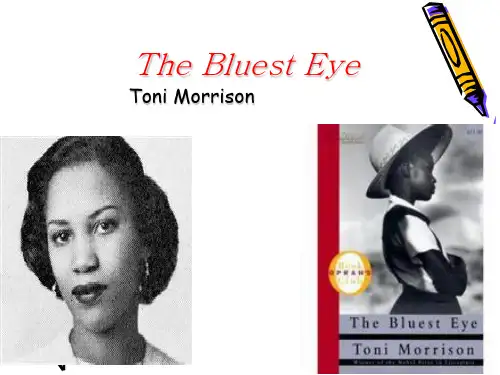
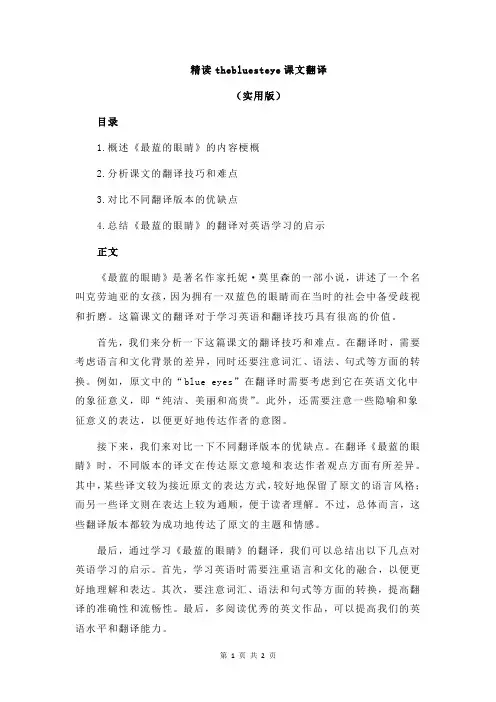
精读thebluesteye课文翻译
(实用版)
目录
1.概述《最蓝的眼睛》的内容梗概
2.分析课文的翻译技巧和难点
3.对比不同翻译版本的优缺点
4.总结《最蓝的眼睛》的翻译对英语学习的启示
正文
《最蓝的眼睛》是著名作家托妮·莫里森的一部小说,讲述了一个名叫克劳迪亚的女孩,因为拥有一双蓝色的眼睛而在当时的社会中备受歧视和折磨。
这篇课文的翻译对于学习英语和翻译技巧具有很高的价值。
首先,我们来分析一下这篇课文的翻译技巧和难点。
在翻译时,需要考虑语言和文化背景的差异,同时还要注意词汇、语法、句式等方面的转换。
例如,原文中的“blue eyes”在翻译时需要考虑到它在英语文化中的象征意义,即“纯洁、美丽和高贵”。
此外,还需要注意一些隐喻和象征意义的表达,以便更好地传达作者的意图。
接下来,我们来对比一下不同翻译版本的优缺点。
在翻译《最蓝的眼睛》时,不同版本的译文在传达原文意境和表达作者观点方面有所差异。
其中,某些译文较为接近原文的表达方式,较好地保留了原文的语言风格;而另一些译文则在表达上较为通顺,便于读者理解。
不过,总体而言,这些翻译版本都较为成功地传达了原文的主题和情感。
最后,通过学习《最蓝的眼睛》的翻译,我们可以总结出以下几点对英语学习的启示。
首先,学习英语时需要注重语言和文化的融合,以便更好地理解和表达。
其次,要注意词汇、语法和句式等方面的转换,提高翻译的准确性和流畅性。
最后,多阅读优秀的英文作品,可以提高我们的英语水平和翻译能力。
总之,《最蓝的眼睛》这篇课文的翻译对于学习英语和翻译技巧具有很高的价值。
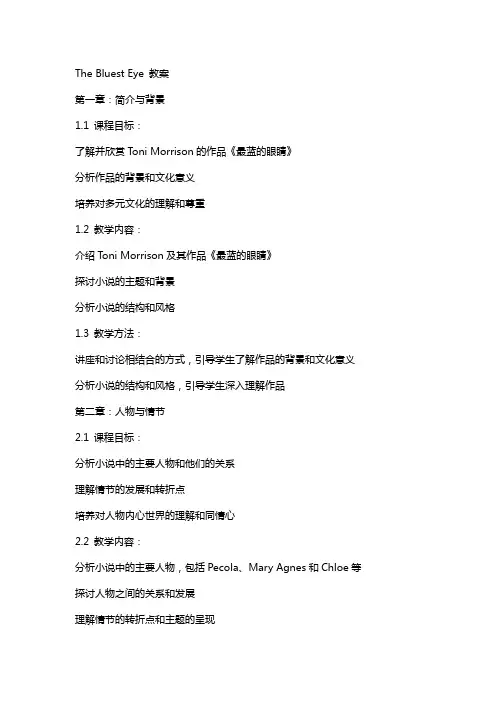
The Bluest Eye 教案第一章:简介与背景1.1 课程目标:了解并欣赏Toni Morrison的作品《最蓝的眼睛》分析作品的背景和文化意义培养对多元文化的理解和尊重1.2 教学内容:介绍Toni Morrison及其作品《最蓝的眼睛》探讨小说的主题和背景分析小说的结构和风格1.3 教学方法:讲座和讨论相结合的方式,引导学生了解作品的背景和文化意义分析小说的结构和风格,引导学生深入理解作品第二章:人物与情节2.1 课程目标:分析小说中的主要人物和他们的关系理解情节的发展和转折点培养对人物内心世界的理解和同情心2.2 教学内容:分析小说中的主要人物,包括Pecola、Mary Agnes和Chloe等探讨人物之间的关系和发展理解情节的转折点和主题的呈现2.3 教学方法:小组讨论和角色扮演,引导学生深入理解人物的性格和动机分析情节的发展和转折点,引导学生理解主题的呈现第三章:主题与象征3.1 课程目标:分析小说的主题和象征意义理解作品对社会现实的批判和反思培养对自我认同和自尊的思考和探讨3.2 教学内容:分析小说的主题,包括对美的追求、种族歧视和贫困等探讨作品中的象征意义,如最蓝的眼睛的象征意义引导学生思考作品对社会现实的批判和反思3.3 教学方法:小组讨论和写作练习,引导学生深入理解主题和象征意义分析作品对社会现实的批判和反思,引导学生思考自我认同和自尊的重要性第四章:文学手法与风格4.1 课程目标:分析小说的文学手法和风格理解作者的叙事技巧和语言特色培养对文学作品的欣赏和评价能力4.2 教学内容:分析小说的叙事技巧,如视角的转换和时间的跳跃等探讨小说的语言特色,如描述、对话和内心独白等引导学生欣赏和评价作者的文学手法和风格4.3 教学方法:小组讨论和写作练习,引导学生深入理解文学手法和风格分析作者的叙事技巧和语言特色,引导学生欣赏和评价作品第五章:批判性思维与讨论5.1 课程目标:培养学生的批判性思维能力引导学生对小说中的主题和情节进行深入讨论培养学生的综合分析和批判能力5.2 教学内容:引导学生对小说中的主题和情节进行深入讨论分析小说中的社会问题和文化冲突引导学生思考作品对现实社会的启示和影响5.3 教学方法:小组讨论和口头报告,引导学生深入理解和批判作品分析社会问题和文化冲突,引导学生思考作品对现实社会的启示和影响第六章:性别与身份6.1 课程目标:分析小说中性别角色和身份认同的主题探讨小说中女性角色的自主性和束缚培养学生对性别平等和多元身份的认识6.2 教学内容:分析小说中女性角色的形象和塑造探讨性别角色对人物命运的影响引导学生思考身份认同与个人成长的关系6.3 教学方法:小组讨论和角色扮演,引导学生深入理解女性角色的自主性和束缚分析性别角色和身份认同的主题,引导学生思考现实生活中的性别平等和多元身份认同问题第七章:家庭与社区7.1 课程目标:分析小说中家庭和社区的关系和影响探讨家庭结构对人物成长的影响培养学生对家庭和社区支持的重视7.2 教学内容:分析小说中家庭关系和社区环境的描绘探讨家庭破裂和社区压迫对人物命运的影响引导学生思考家庭和社区对个人成长的支持和影响7.3 教学方法:小组讨论和案例分析,引导学生深入理解家庭和社区的关系和影响分析家庭结构和支持系统对人物成长的影响,引导学生思考现实生活中的家庭和社区支持的重要性第八章:艺术与美的追求8.1 课程目标:分析小说中艺术和美的追求的主题探讨小说中对美的标准和价值观的批判培养学生对艺术和美的理解和欣赏能力8.2 教学内容:分析小说中艺术创作和美的追求的描写探讨美的标准和价值观的批判和反思引导学生思考个人对艺术和美的追求的意义和价值8.3 教学方法:小组讨论和创作练习,引导学生深入理解艺术和美的追求的主题分析美的标准和价值观的批判,引导学生思考个人对艺术和美的追求的意义和价值第九章:心理与社会的影响9.1 课程目标:分析小说中人物心理和社会环境的相互影响探讨小说中人物的心理变化和社会压力的关系培养学生对心理健康和社会适应的认识和关注9.2 教学内容:分析小说中人物心理的描写和社会环境的背景探讨人物的心理变化和社会压力的相互作用引导学生思考心理健康和社会适应的重要性9.3 教学方法:小组讨论和心理测试,引导学生深入理解人物心理和社会环境的相互影响分析人物的心理变化和社会压力的关系,引导学生关注心理健康和社会适应的重要性第十章:综合讨论与反思10.1 课程目标:培养学生对小说整体理解和批判性思维能力引导学生对小说中的主题和情节进行综合讨论和反思培养学生对文学作品的社会意义和现实影响的思考10.2 教学内容:引导学生对小说中的主题和情节进行综合讨论和反思分析小说中的社会问题和文化冲突的解决方案引导学生思考文学作品对社会现实的影响和启示10.3 教学方法:小组讨论和口头报告,引导学生深入理解和反思作品分析社会问题和文化冲突的解决方案,引导学生思考作品对社会现实的影响和启示重点解析理解Toni Morrison及其作品《最蓝的眼睛》的背景和文化意义分析小说中的主要人物、情节、主题和象征意义探讨小说中的性别角色、家庭和社区关系、艺术和美的追求、心理与社会的影响等议题培养学生对文学作品的理解、欣赏和批判性思维能力引导学生思考文学作品对社会现实的影响和启示引导学生关注家庭支持、心理健康、身份认同、性别平等和多元文化等重要议题。
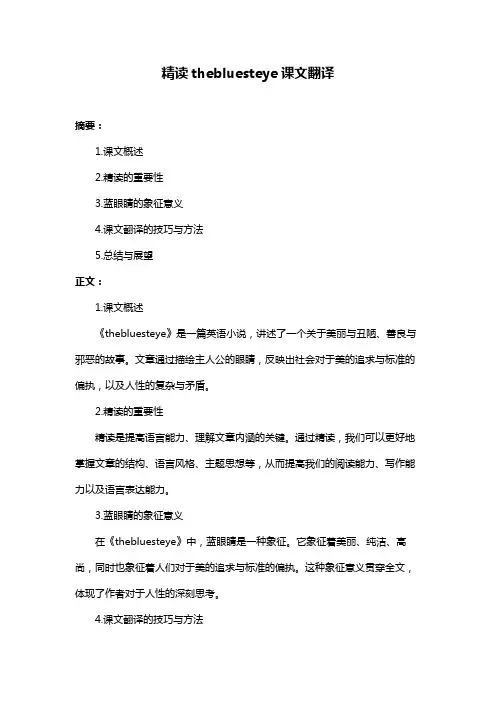
精读thebluesteye课文翻译
摘要:
1.课文概述
2.精读的重要性
3.蓝眼睛的象征意义
4.课文翻译的技巧与方法
5.总结与展望
正文:
1.课文概述
《thebluesteye》是一篇英语小说,讲述了一个关于美丽与丑陋、善良与邪恶的故事。
文章通过描绘主人公的眼睛,反映出社会对于美的追求与标准的偏执,以及人性的复杂与矛盾。
2.精读的重要性
精读是提高语言能力、理解文章内涵的关键。
通过精读,我们可以更好地掌握文章的结构、语言风格、主题思想等,从而提高我们的阅读能力、写作能力以及语言表达能力。
3.蓝眼睛的象征意义
在《thebluesteye》中,蓝眼睛是一种象征。
它象征着美丽、纯洁、高尚,同时也象征着人们对于美的追求与标准的偏执。
这种象征意义贯穿全文,体现了作者对于人性的深刻思考。
4.课文翻译的技巧与方法
翻译课文需要遵循“信、达、雅”的原则,即准确传达原文的意思,表达通顺流畅,符合汉语的语言习惯。
具体方法包括:理解原文、查阅词典、对比翻译、润色表达等。
5.总结与展望
精读《thebluesteye》并进行翻译练习,不仅可以提高我们的英语水平,还可以让我们深入理解人性、审美等话题。
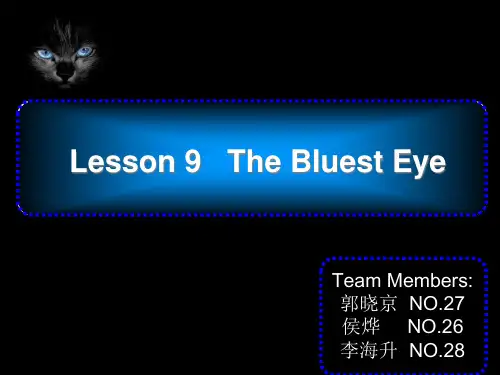
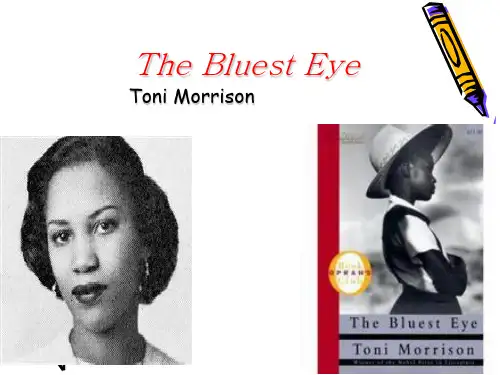
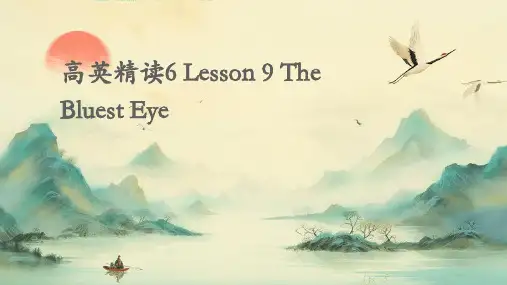
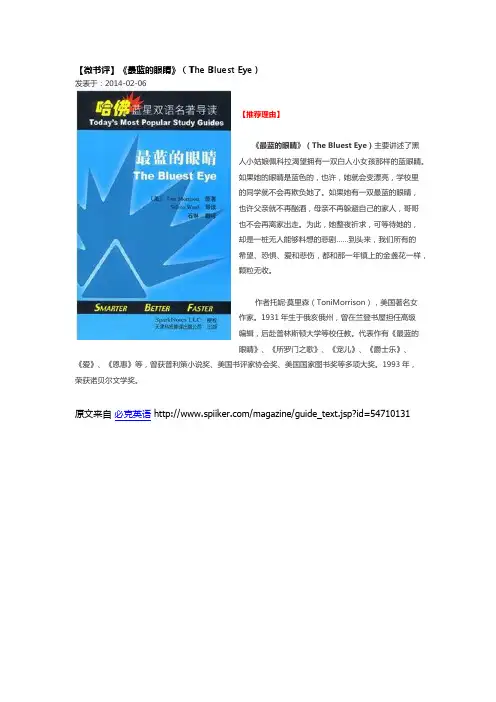
【微书评】《最蓝的眼睛》(The Bluest Eye)
发表于:2014-02-06
【推荐理由】
《最蓝的眼睛》(The Bluest Eye)主要讲述了黑
人小姑娘佩科拉渴望拥有一双白人小女孩那样的蓝眼睛。
如果她的眼睛是蓝色的,也许,她就会变漂亮,学校里
的同学就不会再欺负她了。
如果她有一双最蓝的眼睛,
也许父亲就不再酗酒,母亲不再躲避自己的家人,哥哥
也不会再离家出走。
为此,她整夜祈求,可等待她的,
却是一桩无人能够料想的悲剧……到头来,我们所有的
希望、恐惧、爱和悲伤,都和那一年镇上的金盏花一样,
颗粒无收。
作者托妮·莫里森(ToniMorrison),美国著名女
作家。
1931年生于俄亥俄州,曾在兰登书屋担任高级
编辑,后赴普林斯顿大学等校任教。
代表作有《最蓝的
眼睛》、《所罗门之歌》、《宠儿》、《爵士乐》、《爱》、《恩惠》等,曾获普利策小说奖、美国书评家协会奖、美国国家图书奖等多项大奖。
1993年,
荣获诺贝尔文学奖。
原文来自必克英语 /magazine/guide_text.jsp?id=54710131。
Unit10-The-Bluest-EyeUnit 10 The Bluest Eye(Excerpts)Toni MorrisonAdditional Background InformationToni MorrisonToni Morrison has a unique status in American literature. She is the winner of the National Book Critic Circle Award (1977), the Pulitzer Prize for Fiction (1988) and many other literary awards. She was granted the Nobel Prize for Literature in 1993, thus becoming the first African-American writer to receive this honor. She has published 10 novels, a musical, a play, and a collection of critical essays. Her devoted readers are found all over the world, and they include both sexes and all colors, ages and creeds.A member of both the National Council on the Arts and the American Academy and Institute of Arts and Letters, Morrison has actively used her influence to encourage publication of the works of other African-American writers.Toni Morrison was born Chloe Anthony Wofford in Lorain, Ohio in 1931. She came from a family of sharecroppers, who moved from the South to Ohio to escape Southern racism. At the age of 18 Morrison went to Washington, D.C. to attend Howard University, the most distinguished black college in America, where she became interested in the stage and joined the Howard University Players. After she earned a B.A. in English from Howard she went to Cornell University for graduate studies in English literature. Upon receiving a M.A. from Cornell, she began her teaching career. From 1955 to 1957 she taught English at Texas Southern University, and from 1957 to 1964 she taught atHoward. In 1965, she became a senior editor at Random House, where she edited a number of African-American writers. In 1958 she married Harold Morrison, a Jamaican architect and had two sons. In 1964 they divorced and she raised the two sons by herself. She began writing in 1962. Her first work was a short story, which would later develop into her first novel The Bluest Eye (1970). It tells the story of a little black girl named Pecola Breedlove, who yearns to have the beautiful blue eyes of a white girl. She believes that if only she had blue eyes, her life would be happy.In 1971 Morrison resumed her teaching career, teaching English at New York University, serving as a visiting professor at Yale from 1976 to 1978, at the State University of New York at Albany from 1984 to 1989. Since 1989 she has been teaching at Princeton University as a member of the African-American studies program and of the creative writing department. Meanwhile she continued her writing. Her next novel, Sula (1974) examines the friendship between two black women Sula and Nel, depicting how they grew up together but took different life paths in their maturity. The novel won the National Book Critic Award. The Song of Solomon, published in1977, was a greater success than her previous novels. Set in Michigan in the early 1930s, the novel is narrated from a male’s point of view. In his efforts to recover his ancestor’s property, a sack of gold, Milkman Dead rediscovers his racial roots and cultural identity. The novel was a Book-of-the-Month Club selection, and it placed Toni Morrison in the first rank of American novelists. Tar Baby came out in 1981. Unlike her previous novels, this book has both African-American and white characters. By juxtaposing them in the central conflict of the plot, the author dramatizes the racial complexities that characterize the Americancultural landscape. Published in 1987, Morrison’s next work Beloved deals with slavery and infanticide. It was another triumph and the winner of the Pulitzer Prize for Fiction. The protagonist Sethe has run away from slavery and is seeking refuge in Ohio. When the slave masters search for her, she kills her baby girl in order to save her from the slavery she has just escaped. However, t he ghost of the baby “Beloved”, a name written on her tombstone, comes back to haunt her. In Jazz (1992), Joe, the unfaithful husband of Violet, kills a girl he loves so much in a fit of passion. The fragmented narrative gradually unfolds, showing how and why this Harlem, New York tragedy happened. In Paradise(1998), which moves freely between eras, the author explores the founding of Ruby, a tiny all-black farming community in Oklahoma, and its ancestral feuds and financial quarrels.This novel was followed by Love (2003), A Mercy (2008) and Home (2012). In addition to her novels, Morrison has also written short fiction, plays and non-fiction. Playing in the Dark: Whiteness and the Literary Imagination (1992) is a collection of literary criticism.Morrison’s novels are mostly set in black communities in the thirties or forties, but they do not merely tell stories about a particular community during a particular period. Morrison does far more than just t ell good stories. When talking about the novel, she says, “It should be beautiful, and powerful, but it should also work. It should have something in it that enlightens; something in it that opens the door and points the way; something in it that suggests what the conflicts are, what the problems are. But it need not solve those problems because it is not a case study, it is not a recipe. ... If anything I do, in the way of writing novels (or whatever I write), isn’t a bout the village orthe community or about you, then it is not about anything. I am not interested in indulging myself in some private, closed exercise of my imagination that fulfills only the obligation of my personal dreams—which is to say yes, the work must be political. ... It seems to me that the best art is political and you ought to be able to make it unquestionably political and irrevocably beautiful at the same time.” (“Rootedness: The Ancestor as Foundation”) The Nobel Prize citation points out, “In her depictions of the world of the b lack people, in life as in legend, Toni Morrison has given the Afro-American people their history back, piece by piece.” Yet, at the same time, her work is always symbolic of the shared human condition, transcending lines of gender, race, and class. The most enduring impression her novels leave is of “empathy, of compassion with one’s fellow human beings”.In 2012 Tony Morrison received the Presidential Medal of Freedom.The Bluest EyePublished in 1970, the novel is set in the black community in Lorain, Ohio, in 1941, long before the Civil Rights Movement. In those days, blackness was synonymous with ugliness. The dominant white culture exercised its hegemony and dictated standards of beauty. Many black people accepted and internalized white values and developed self-contempt and self-hatred for themselves or other black people, making some of their own people victims and scapegoats. To overthrow white cultural hegemony and liberate themselves from oppression and self-oppression, in the 1960s, black people raised the political slogan: “Black is beautiful.”Morrison’s novel The Bluest Eyes depicts the perniciouspsychological impact that the dominant white cultural values have had on black people.The story centers around the tragic life of a little black girl named Pecola Breedlove. The Breedloves were the poorest family in the town, living in the front of an abandoned store. The place was so ugly that “visitors who drive to this tiny town wonder why it has not been torn down, while pedestrians, who are re sidents of the neighborhood, simply look away when they pass it”. Pecola, eleven years old, was black and ugly. Her father, Cholly Breedlove, was driven to alcoholism by a life of appalling racial oppression. Once he burned up his house and turned his family outdoors. Her mother, Pauline, driven by her husband’s rage and the unbearable misery of her life, found peace only through working as a servant in a white home. She gave more care and attention to her master’s child ren than her own little girl. The poverty-stricken and frustrated couple quarreled and fought constantly, totally ignoring their daughter Pecola. At school other children bullied and ridiculed her, calling her ugly. Imprisoned by dire poverty and extreme misery, Pecola wished for lighter skin, blond hair and especially blue eyes like movie star Shirley Temple and other white girls. Every day she prayed for a miracle that would give her a pair of the bluest eyes. She believed that her ugliness was the source of all her misery and that having blue eyes would be the key to happiness. She was convinced that if she had blue eyes, she would become pretty and happy and that all her problems would be gone. Finally, becoming mad,she thought that her eyes had become blue. In her imagination she had been transformed into a pretty girl. As she was waiting for love and happiness to come to her, ironically her drunken father got home, and ga ve “love” to his daughter by raping her. Thelittle girl became pregnant and she gave birth to a stillborn child. She sank deeper into despair and madness. By the end of the novel, “She was so sad to see. Grown people looked away; children, those who were not frightened by her, laughed outright...the damage done was total.” Pecola’s fat her died in the workhouse; her mother still did housework for white people. Pecola and her mother moved to a little house on the edge of town. The black little girl wa s often seen picking her way “between the tire rims and the sunflowers, among all the wa ste and beauty of the world—which is what she herself was”. The narrator planted some marigolds in the spring that year, but they never came out. Using the dead seeds of marigolds as a metaphor, the narrator observes in conclusion, “I even think now that theland of the entire county was hostile to marigolds that year. This soil is bad for certain kinds of flowers. Certain seeds it will not nurture, certain fruit it will not bear, and when the land kills of its own volition, we acquiesce and say the victim had no right to live. We are wrong, of course, but it doesn’t matter. It’s too late. At least on the edge of my town, among the garbage and the sunflowers of my town, it’s much, much, much too late.” Pecola is a victim of racial oppression and a scapegoat for the self-oppression and self-hatred existing in the black community.The Bluest Eye gives voice to the experience of growing up black in a society dominated by white, middle-class ideology. Morrison once said, “Beauty, love...actually, I think, all the time that I write, I’m writing about love or its absence. ... I thought in The Bluest Eye, that I was writing about beauty, miracles, and self-images, about the way in which people can hurt each other, about whether or not one is beautiful.”The author begins the novel with a simple 1946 primer text, one of the first things every American child read in the 1970s when he/she began school. This white, middle-class reader text goes like this:Here is the house. It is green and white. It has a red door. It is very pretty. Here is the family.Mother, Father, Dick, and Jane live in the green-and-white house. They are very happy. See Jane. She has a red dress. She wants to play. Who will play with Jane? See the cat. It goes meow-meow. Come and play. Come and play with Jane. The kitten will not play. See Mother.Mother is very nice. Mother, will you play with Jane? Mother laughs. Laugh, Mother, laugh.See Father. He is big and strong. Father, will you play with Jane? Father is smiling. Smile, Father, smile. See the dog. Bowwow goes the dog. Do you want to play with Jane? See the dog run. Run, dog, run. Look, look. Here comes a friend. The friend will play with Jane. They will play a good game. Play, Jane, play.Morrison said in an interview, “In The Bluest Eye I used the primer story, with its picture of a happy family, as a frame acknowledging the outer civilization. The primer with white children was the way life was presented to the black people.” In reality, the black life is quite the opposite of the typical middle-class white life described in the primer. Pecola is not Jane. She is completely a victim of her circumstances.Structure of the TextI.In Section One the author describes a type of character—the brown girls. (Paras. 1-9)1.Brown girls have lighter skins than other black people. They are from towns in the DeepSouth. (Para. 1)2.The brown girls are trying hard to imitate the white middle-class way of life. (Para. 2)3.These brown girls have not only assimilated the way of life but also the ideology of the whitemiddle-class. They receive more formal school education than their poorer sisters, and as a result they are more alienated from their black cultural heritage. (Paras. 3-4)4.Although these brown girls never seem to have boyfriends, they always marry and becomegood housewives. (Para. 5)5.What men do not know is that the brown girl will make her home her own inviolable worldclosing out any outsider, even against her husband. She runs the house in her own way.Although she keeps the house clean and tidy, she does not give it any warmth. (Paras. 6-9) II.In Section Two the author tells the story of a black girl Pecola: how she was treated badly by Louis Junior and his mother Geraldine. (Paras. 11-53)1.Geraldine was a typical brown woman. She had a son called Louis Junior. Although she methis physical needs, she failed to give him warmth and love. She taught him to hate children with blacker skins. As a result Louis Junior became a selfish and cruel boy. (Paras 11-14)2.One day Louis Junior saw Pecola walking by. He thought this girl with a dark skin was ugly,and decided to be mischievous with her. He asked her to come to his house, telling her that he had a kitten to show her. ( Paras. 15-34)3.Curious to see the kitten, Pecola came to Louis Junior’shouse. As she was admiring thebeautiful house, the boy threw a big black cat right in her face. (Para. 35)4.Seeing Pecola fond of the cat, Louis Junior snatched the cat by one of its hind legs and beganto swing it around his head in a circle. Pecola tried to stop Louis Junior. In their struggling, Louis Junior let go of the cat, and it was thrown against the window, almost dead. (Paras. 36-44)5.Geraldine came back home. She looked at Pecola. As Geraldine saw her, Pecola representedextreme ugliness and dire poverty, things she had avoided and hated all her life. She ordered the miserable girl to get out of her house6.Outside, snow was falling. Pecola was cold and lonely.Detailed Analysis of the Text1. How is the text structured?Taken from a novel, our text is not exactly like a complete, well-structured story. We may roughly divide the text into two parts. Paragraphs 1-9, which form the first section, describe a type of character—the brown girls. Part Two, which begins from Paragraph 10, tells the story about what happens to the little black girl Pecola in the house of such a brown woman.2. They come from Mobile. Aiken. From Newport News. From Marietta. From Meridian. (Para. 1)Note:“They” refer s to a character type the author describes in this passage. They are brown girls who have lighter skins than other black people because of their mixed blood. Many of them are descendents of former slaves who were house servants.Working in the house rather than in the fields, they were closer to their white slave owners than the field Negroes. It was a common thing for a white master to have babies with black maids. These house servants usually felt superior to field Negroes.Note:The author mentions several places: Mobile (in southwestern Alabama), Aiken (in western South Carolina), Newport News (in southeastern Virginia), Marietta (in northwestern Georgia) and Meridian (in eastern Mississippi). There is one thing in common among them, that is, they are all towns in the Deep South, where slavery and the plantation system existed before the Civil War. The setting of the novel The Bluest Eye is an industrial town called Lorain in Ohio, which is in the Midwest and different from the Deep South.3. And the sounds of these places in their mouths make you think of love. (Para. 1)When the brown girls pronounce the names of these places, their voices are so sweet and full of affection that other people associate these places with love.4. they tilt the ir heads and say “Mobile” and you think you’ve been kissed. (Para. 1)They say “Mobile” with pride. “You think you’ve been kissed” is another way of saying “the sounds of these places in their mouths make you think of love”.5. They say “Aiken” and you see a white butterfly glance off a fence with a torn wing. (Para.1)to glance off: to hit a surface at an angle and then move away from it in another directiona white butterfly glance off a fence with a torn wing: Here theauthor uses a butterfly with a torn wing as a metaphor, meaning fragile beauty.Note:The implied meaning is that life in the Deep South seems romantic and fills them with sentimental nostalgia, although life there is not easy.6. “Yes, I will.” (Para. 1)Agai n, this is associated with “love”. When a man proposes marriage, he asks the woman, “Will you marry me?” If the woman agrees to marry him, her answer will be: “Yes, I will.”7. but you love what happens to the air when they open their lips and let the names ease out. (Para. 1)That means they say those names in a very gentle and tender manner.8. How does the author describe the brown girls from the Deep South cities in Paragraph 2? In this paragraph the author gives a general picture of who these brown girls are, what they are like, and how they live. The descriptions show that they are trying hard to imitate the white middle-class way of life.9. The sound of it opens the windows of a room like the first four notes of a hymn. (Para 2)SimileParaphrase:When one sings a hymn, the first few notes fill one’s heart with an air of freshness, just like opening a window. The sound of Meridian’s four-syllable has the same effect.hymn: a song of praise to God10. Few people can say the names of their hometowns with such sly affection. (Para. 2): Paraphrase:Not many people feel this kind of secret affection when they say the names of their hometowns. sly: suggesting that you know something secret that other people do not know.E.g. a sly smile11. Perhaps because they don’t have home towns, just places where they were born. (Para. 2) Paraphrase:This is perhaps because they only have places of birth, but not places where they feel at home and which they identify themselves with.Note:Unlike these brown girls who come from the Deep South with a deeply-rooted tradition, most people working in this industrial town are from everywhere, and they move around when their jobs change.Note:This sentence presumes that America is a mobile society in which people tend to move around instead of staying in one place all their lives. Note the difference between a place where one was born and a hometown. In American culture, a hometown may or may not be one’s place of birth. It is a place of personal experiences, a place where one feels most at home and which one identifies with most. In Chinese culture one’s hometown is on e’s place of birth or one’s ancestral place and that of one’s family, the place where one has cultural roots.12. But these girls soak up the juice of their home towns, and it never leaves them. (Para. 2) MetaphorParaphrase:But these girls are strongly influenced by their hometowns, and the influence stays with them forever even after they leave their hometowns.to soak up: to take in or absorb liquidjuice: the liquid that comes from fruit or vegetables; (slang) power and influence13. They have the eyes of people who can tell what time it is by the color of the sky. (Para. 2)他们的眼睛可以根据天空的颜色判断是什么时间了。
The Bluest Eye 教案第一章:引言与背景1.1 课程目标了解并欣赏Toni Morrison的作品《最蓝的眼睛》探索小说的主题和象征意义培养学生的批判性思维和文学分析能力1.2 教学内容介绍Toni Morrison和她的作品《最蓝的眼睛》讨论小说的背景和出版历史概述小说的主要情节和角色1.3 教学方法采用小组讨论和写作活动来促进学生的参与和思考使用多媒体资源和文学批评文章来丰富教学内容鼓励学生进行自主阅读和反思第二章:人物与情节2.1 课程目标分析小说中的主要人物和他们的关系探讨小说的情节发展和人物动机2.2 教学内容分析主人公Pecola的背景和性格特点探讨其他重要人物如Mama, Pa, Cholly和Self的角色的作用研究小说中的事件和冲突如何推动情节发展进行角色扮演和情景模拟来深入理解人物性格和动机分析小说的章节结构,了解故事的发展和转折点引导学生进行文学作品的批判性思考和讨论第三章:主题与象征3.1 课程目标探索小说中的主要主题和象征意义分析小说中的象征元素和它们对主题的贡献3.2 教学内容探讨小说的主题,如种族、阶级、性别和美的标准分析小说中的象征元素,如最蓝的眼睛、房子和宗教3.3 教学方法进行小组讨论和写作活动,让学生探索和表达他们对主题和象征的理解使用文献资料和学术文章来支持对主题和象征的深入分析鼓励学生进行创意写作,以培养他们的创造力和表达能力第四章:文学技巧与风格4.1 课程目标分析小说的文学技巧和风格探讨这些技巧和风格如何增强小说的主题和情节4.2 教学内容分析小说的叙述视角和叙事结构探讨Morrison的语言使用和叙述风格进行文学作品的分析和解读,以深入理解其技巧和风格使用案例研究和写作活动来培养学生的批判性思维和分析能力鼓励学生进行创意写作,以模仿和创作具有深度和风格的作品第五章:批判性思维与写作5.1 课程目标培养学生的批判性思维和分析能力提高学生的写作技巧和表达能力5.2 教学内容分析小说的批判性观点和问题5.3 教学方法进行小组讨论和写作活动,培养学生的批判性思维和分析能力提供写作指导和反馈,以帮助学生提高写作技巧和表达能力鼓励学生进行自主学习和反思,以培养他们的独立思考能力第六章:种族与身份6.1 课程目标探讨小说中种族问题对人物和情节的影响分析小说如何揭示种族和身份的复杂性6.2 教学内容研究种族如何在小说中塑造人物形象和故事发展探讨种族和身份如何影响人物的自我认同和社会地位6.3 教学方法进行小组讨论和角色扮演,让学生深入理解种族和身份对人物的影响分析小说中的种族冲突和社会不公,引导学生思考现实世界中的相关问题鼓励学生进行自主研究,探讨不同文化背景下种族和身份的问题第七章:家庭与成长7.1 课程目标分析小说中家庭关系对人物成长的影响探讨小说如何展现家庭冲突和人物内心的挣扎7.2 教学内容研究家庭成员之间的关系和它们对人物成长的影响分析小说中的家庭暴力和亲子关系问题7.3 教学方法进行家庭场景的角色扮演和讨论,让学生深入理解家庭关系对成长的impact 分析小说的章节和情节,探讨家庭冲突如何塑造人物性格和命运鼓励学生进行写作活动,分享自己的家庭经历和成长故事第八章:社会与文化8.1 课程目标探讨小说中的社会和文化问题及其对人物的塑造分析小说如何反映当时的社会和文化背景8.2 教学内容研究小说中的社会阶层和贫富差距问题探讨小说中的性别角色和女性形象8.3 教学方法分析小说的社会和文化背景,引导学生思考现实世界中的相关问题进行小组讨论和写作活动,让学生探讨社会和文化问题对人物的influence 鼓励学生进行自主研究,了解不同社会和文化背景下的性别角色和阶层问题第九章:心理分析与人物塑造9.1 课程目标分析小说中人物的心理活动和内心世界探讨心理分析如何影响人物塑造和故事发展9.2 教学内容研究人物的内心挣扎和心理问题分析小说中的心理分析和人物心理变化9.3 教学方法进行心理分析的角色扮演和讨论,让学生深入理解人物的心理状态分析小说的章节和情节,探讨心理分析如何塑造人物性格和命运鼓励学生进行写作活动,创作以心理分析为主题的故事或人物描述第十章:总结与反思10.1 课程目标总结学习成果,回顾小说的主题和情节反思个人对小说的理解和感受10.2 教学内容进行小组讨论,分享对小说的理解和感受回顾小说的主题、情节和人物,总结学习成果10.3 教学方法组织小组讨论,让学生分享对小说的理解和感受重点和难点解析一、引言与背景:理解Toni Morrison和她的作品《最蓝的眼睛》的背景和出版历史,为后续的学习打下基础。
Toni Morrison and 《The Bluest Eye》I、Toni MorrisonToni Morrison (born Chloe Anthony Wofford on February 18, 1931), is a Nobel Prize-winning American author, editor, and professor. Her novels are known for their epic themes, vivid dialogue, and richly detailed black characters; among the best known are her novels The Bluest Eye, Song of Solomon, and Beloved, which won the Pulitzer Prize for Fiction in 1988. In 2001 she was named one of the "30 Most Powerful Women in America" by Ladies' Home Journal.1、Early life and careerToni Morrison was born in Lorain, Ohio, the second of four children in a working-class family. As a child, Morrison read constantly; among her favorite authors were Jane Austen and Leo Tolstoy. Morrison's father, George Wofford, a welder by trade, told her numerous folktales of the black community (a method of storytelling that would later work its way into Morrison's writings).In 1949 Morrison entered Howard University to study English. While there she began going by the nickname of "Toni," which derives from her middle name, Anthony. Morrison received a B.A. in English from Howard in 1953, then earned a Master of Arts degree, also in English, from Cornell University in 1955, for which she wrote a thesis on suicide in the works of William Faulkner and Virginia Woolf. After graduation, Morrison became an English instructor at Texas Southern University inHouston, Texas (from 1955-57) then returned to Howard to teach English. She became a member of Alpha Kappa Alpha Sorority, Inc.In 1958 she married Harold Morrison. They had two children, Harold and Slade, and divorced in 1964. After the divorce she moved to Syracuse, New York, where she worked as a textbook editor. Eighteen months later she went to work as an editor at the New York City headquarters of Random House.As an editor, Morrison played an important role in bringing African American literature into the mainstream. She edited books by such black authors as Toni Cade Bambara, Angela Davis and Gayl Jones.2、Writing careerMorrison began writing fiction as part of an informal group of poets and writers at Howard University who met to discuss their work. She went to one meeting with a short story about a black girl who longed to have blue eyes. The story later evolved into her first novel, The Bluest Eye (1970), which she wrote while raising two children and teaching at Howard. In 2000 it was chosen as a selection for Oprah's Book Club.In 1973 her novel Sula was nominated for the National Book Award. Her third novel, Song of Solomon (1977), brought her national attention. The book was a main selection of the Book-of-the-Month Club, the first novel by a black writer to be so chosen since Richard Wright's Native Son in 1940. It won the National Book Critics Circle Award.In 1988 Morrison's novel Beloved became a critical success. When the novel failed to win the National Book Award as well as the National Book Critics Circle Award, a number of writers protested the omission. Shortly afterward, it won the Pulitzer Prize for fiction. Beloved was adapted into the 1998 film of the same name starring Oprah Winfrey and Danny Glover. Morrison later used Margaret Garner's life story again in an opera, Margaret Garner, with music by Richard Danielpour. In May 2006, The New York Times Book Review named Beloved the best American novel published in the previous twenty five years.In 1993 Morrison was awarded the Nobel Prize in Literature, the first black woman to win it. Her citation reads: Toni Morrison, "who in novels characterized by visionary force and poetic import, gives life to an essential aspect of American reality." Shortly afterwards, a fire destroyed her Rockland County, New York home. Although her novels typically concentrate on black women, Morrison does not identify her works as feminist. She has stated that she thinks "it's off-putting to some readers, who may feel that I'm involved in writing some kind of feminist tract. I don't subscribe to patriarchy, and I don't think it should be substituted with matriarchy. I think it's a question of equitable access, and opening doors to all sorts of things. In addition to her novels, Morrison has also co-written books for children with her youngest son, Slade Morrison, who works as a painter and musician.3、Later lifeMorrison taught English at two branches of the State University of New York. In 1984 she was appointed to an Albert Schweitzer chair at the University at Albany, The State University of New York. From 1989 until her retirement in 2006, Morrison heldthe Robert F. Goheen Chair in the Humanities at Princeton University.Though based in the Creative Writing Program, Morrison did not regularly offer writing workshops to students after the late 1990s, a fact that earned her some criticism. Rather, she has conceived and developed the prestigious Princeton Atelier, a program that brings together talented students with critically acclaimed, world-famous artists. Together the students and the artists produce works of art that are presented to the public after a semester of collaboration. In her position at Princeton, Morrison used her insights to encourage not merely new and emerging writers, but artists working to develop new forms of art through interdisciplinary play and cooperation. At its 1979 commencement ceremonies, Barnard College awarded her its highest honor, the Barnard Medal of Distinction. Oxford University awarded her an honorary Doctor of Letters degree in June 2005.In November 2006, Morrison visited the Louvre Museum in Paris as the second in its "Grand Invité" program to guest-curate a month-long series of events across the arts on the theme of "The Foreigner's Home."She currently holds a place on the editorial board of The Nation magazine.PoliticsMorrison caused a stir when she called Bill Clinton "the first Black President;" saying "Clinton displays almost every trope of blackness: single-parent household, born poor, working-class, saxophone-playing, McDonald's-and-junk-food-loving boy from Arkansas." This opinion was both adopted by Clinton supporters like the Congressional Black Caucus (CBC) and ridiculed by critics. It should be noted that, in the context of the 2008 Democratic Primary campaign, during which Clinton made some remarks that were construed as unsympathetic to African-Americans, Morrison revisited her statement. Morrison stated to Salon magazine: "People misunderstood that phrase. I was deploring the way in which President Clinton was being treated, vis-à-vis the sex scandal that was surrounding him. I said he was being treated like a black on the street, already guilty, already a perp. I have no idea what his real instincts are, in terms of race." However, in the 2008 presidential race, Morrison has endorsed Senator Barack Obama over Senator Hillary Clinton.II、The Bluest EyeThe Bluest Eye is 1970 novel by American author Nobel Prize recipient Toni Morrison. Morrison's first novel, which was written while Morrison taught at Howard University and was raising her two sons on her own, the story is about a year in the life of a young black girl in Lorain, Ohio named Pecola. It takes place against the backdrop of America's Midwest as well as the Great Depression. The Bluest Eye is told from five perspectives: Pecola's, her mother's, her father's, her friend Claudia's, and Soaphead Church's. Because of the controversial nature of the book, which deals with racism, incest, and child molestation, there have been numerous attempts to ban it from schools and libraries. In 2000, the novel became a selection for Oprah's Book Club.1、Plot summaryThe narrator advises the reader not to look at the "why" of the story but at the "how." The novel, with child sex, irresponsible adults, and corrupt society seeks to show the misery of black people living in a white society. When she indirectly refers to Pecola as "dirt" and to the Breedloves as animals, she is exposing the ills to which they are submitted. Soaphead Church's letter to God is a summary of the insanity of the world around him, as the novel could be for the author. The Bluest Eye is the story of eleven-year-old Pecola Breedlove--a black girl who is regarded “ugly” by everyone, including her parents--who prays for her eyes to turn blue: so that she will be beautiful, so that people will look at her, so that her world will be different. She is raped by her drunk father and get pregnant, later she gives birth to a stillborn(夭折的)child. Finally Pecola lose her mind and spend the rest of her life as a madwoman thinking she has the bluest eyes of the world…Pecola's parents' history is examined throughout the novel, showing who they are in three main parts: her father Cholly's background, her mother Pauline's past life, and the couple's conflicted marriage. Cholly was deserted by both his parents, and was rebuked when he tried to contact his father. His son seems to do the same thing later on, running away repeatedly.In the afterword, Morrison explains that she is attempting to humanize all the characters that attack Pecola or cause her to be the way she is; that it is not a matter where one person can be pointed out as being the cause of all this pain.Ideas of beauty, particularly those that relate to racial characteristics, are a majortheme in this book. The title refers to Pecola's wish that her eyes would turn blue. Claudia is given a white baby doll to play with and is constantly told how lovely it is. Insults to the appearance are often given in racial terms. A light-skinned schoolmate is favored by the teachers.There is a contrast between the world shown in the cinema, the one in which Pauline is a servant, the WASP society, and the existence the main characters live in. Most chapters' titles are extracts from a Dick and Jane reading book, presenting a happy white family. This family is contrasted with Pecola's existence.ThemeSource of the tragedy: black people accepted and internalized white values and developed self-contempt and self-hatred for themselves or other black people, making some of their own people victims and scapegoats .The impact of mainstream white culture upon black people, which make them victim of the circumstances.2、CharactersPecola Breedlove - The protagonist of the novel, a poor black girl who believes she is ugly because she and her community base their ideals of beauty on "whiteness". The title The Bluest Eye is based on Pecola's fervent wishes for beautiful blue eyes. She is rarely developed during the story, which is purposely done to underscore the actions of the other characters. Her insanity at the end of the novel is her only way to escape the world where she cannot be beautiful and to get those blue eyes she wanted to get since the beginning of the novel.Cholly Breedlove - Pecola's abusive father, an alcoholic man who rapes his daughter at the end of the novel. Rejected by his father and discarded by his mother as a four day old baby, Cholly was raised by his Great Aunt Jimmy. After she dies, Cholly runs away and pursues the life of a "free man", yet he is never able to escape his painful past, nor can he live with the mistakes of his present. Tragically, he rapes his daughter in a gesture of madness mingled with affection. He realizes he loves her, but the only way he can express it is to rape her.Pauline Breedlove - Pecola's mother. Mrs. Breedlove is married to Cholly and lives the self-righteous life of a martyr, enduring her drunk husband and raising her two awkward children as best she can. Mrs. Breedlove is a bit of an outcast herself with her shriveled foot and Southern background. Mrs. Breedlove lives the life of a lonely and isolated character who escapes into a world of dreams, hopes and fantasy that turns into the motion pictures she enjoys viewing.Sam Breedlove - Pecola's older brother. Sammy is Cholly and Mrs. Breedlove's one son. Sam's part in this novel is relatively low key. Like his sister Pecola, he is affected by the disharmony in their home and deals with his anger by running away from home.Claudia MacTeer - Much of the novel is told from the perspective of Claudia. She is the primary narrator in the book. Claudia is Pecola's friend and the younger sister of Frieda MacTeer. The MacTeer family serves as a foil for the Breedloves, and althoughboth families are poor, Mr. and Mrs. MacTeer are strict but loving parents towards their children - a sharp contrast to the dysfunctional home of the Breedloves.Frieda MacTeer - Claudia's older sister and close companion. The two MacTeer girls are often seen together and while most of the story is told through Claudia's eyes, her sister Frieda plays a large role in the novel.Henry Washington - a man who comes to live with the MacTeer family and is subsequently thrown out by Claudia's father when he inappropriately touches Frieda. Soaphead Church - a pedophile and mystic fortune teller who "grants" Pecola her wish for blue eyes. The character is somewhat based on Morrison's Jamaican ex-husband.Great Aunt Jimmy - Cholly's aunt who takes him in to raise after his parents abandon him. She dies when he is a young boy.Maureen Peal - A light-skinned, wealthy mulatto girl who is new at the local school. She accepts everyone else’s assumption that she is superior and is capable of both generosity and cruelty. She changes her attitude throughout the novel towards Pecola.3、AdaptationThe Steppenwolf Theatre Company in Chicago, Illinois commissioned Lydia R. Diamond to adapt the novel into a full-length stage production. The play was developed through the Steppenwolf for Young Adults and the New Plays Initiative where it received its world premiere in February, 2005. The play was reprised in Chicago at the Steppenwolf Theatre in October, 2006 by popular demand. The Bluest Eye received its off-Broadway premiere at the New Victory Theater in New York in November, 2006.The Bluest Eye written by African American writer Toni Morrison narrates a tragic story about a black girl who longs for a pair of blue eyes owned exclusively by white people. Strongly influenced by white dominated culture, many other black women are also lost in the myth of white beauty. However, in addition to the description of this negative impact, Morrison, in her novel, also explores effective approaches to demystify the myth of white beauty and maintain the real-self of the black people through the voice of a rebellious narrator.4、MotifsMotifs are recurring structures, contrasts, or literary devices that can help to develop and inform the text’s major themes.The Dick-and-Jane NarrativeThe novel opens with a narrative from a Dick-and-Jane reading primer, a narrative that is distorted when Morrison runs its sentences and then its words together. The gap between the idealized, sanitized, upper-middle-class world of Dick and Jane (who we assume to be white, though we are never told so) and the often dark and ugly world of the novel is emphasized by the chapter headings excerpted from the primer. But Morrison does not mean for us to think that the Dick-and-Jane world is better—in fact, it is largely because the black characters have internalized white Dick-and-Jane values that they are unhappy. In this way, the Dick and Jane narrative and the novel provide ironic commentary on each other.The Seasons and NatureThe novel is divided into the four seasons, but it pointedly refuses to meet the expectations of these seasons. For example, spring, the traditional time of rebirth and renewal, reminds Claudia of being whipped with new switches, and it is the season when Pecola’s is raped. Pecola’s baby dies in autumn, the season of harvesting. Morrison uses natural cycles to underline the unnaturalness and misery of her characters’ ex periences. To some degree, she also questions the benevolence of nature, as when Claudia wonders whether “the earth itself might have been unyielding” to someone like Pecola.Whiteness and ColorIn the novel, whiteness is associated with beauty and cleanliness (particularly according to Geraldine and Mrs. Breedlove), but also with sterility. In contrast, color is associated with happiness, most clearly in the rainbow of yellow, green, and purple memories Pauline Breedlove sees when making love with Cholly. Morrison uses this imagery to emphasize the destructiveness of the black community’s privileging of whiteness and to suggest that vibrant color, rather than the pure absence of color, is a stronger image of happiness and freedom.Eyes and VisionPecola is obsessed with having blue eyes because she believes that this mark of conventional, white beauty will change the way that she is seen and therefore the way that she sees the world. There are continual references to other characters’ eyes as well—for example, Mr. Yacobowski’s hostility to Pecola resides in the blankness in his own eyes, as well as in his inability to see a black girl. This motif underlines the novel’s repeated concern for the difference between how we see and how we are seen, and the difference between superficial sight and true insight.Dirtiness and CleanlinessThe black characters in the novel who have internalized white, -middle-class values are obsessed with cleanliness. Geraldine and Mrs. Breedlove are excessively concerned with housecleaning—though Mrs. Breedlove cleans only the house of her white employers, as if the Breedlove apartment is beyond her help. This fixation on cleanliness extends into the women’s moral and emotional quests for purity, but the obsession with domestic and moral sanitation leads them to cruel coldness. In contrast, one mark of Claudia’s strength of character is her pleasure in her own dirt, a pleasure that represents self-confidence and a correct understanding of the nature of happiness.5、SymbolsSymbols are objects, characters, figures, or colors used to represent abstract ideas or concepts.The HouseThe novel begins with a sentence from a Dick-and-Jane narrative: “Here is thehouse.” Homes not only indicate socioeconomic status in this novel,but they also symbolize the emotional situations and values of the characters who inhabit them. The Breedlove -apartment is miserable and decrepit, suffering from Mrs. Breedlove’s preference for her employer’s home over her own and symbolizing the misery of the Breedlove family. The MacTeer house is drafty and dark, but it is carefully tended by Mrs. MacTeer and, according to Claudia, filled with love, symbolizing that family’s comparative cohesion.Bluest Eye(s)To Pecola, blue eyes symbolize the beauty and happiness that she associates with the white, middle-class world. They also come to symbolize her own blindness, for she gains blue eyes only at the cost of her sanity. The “bluest” eye could also mean the saddest eye. Furthermore, eye puns on I, in t he sense that the novel’s title uses the singular form of the noun (instead of The Bluest Eyes) to express many of the characters’ sad isolation.The MarigoldsClaudia and Frieda associate marigolds with the safety and well-being of Pecola’s baby. Their ceremonial offering of money and the remaining unsold marigold seeds represents an honest sacrifice on their part. They believe that if the marigolds they have planted grow, then Pecola’s baby will be all right. More generally, marigolds represent the constant renewal of nature. In Pecola’s case, this cycle of renewal is perverted by her father’s rape of her.。